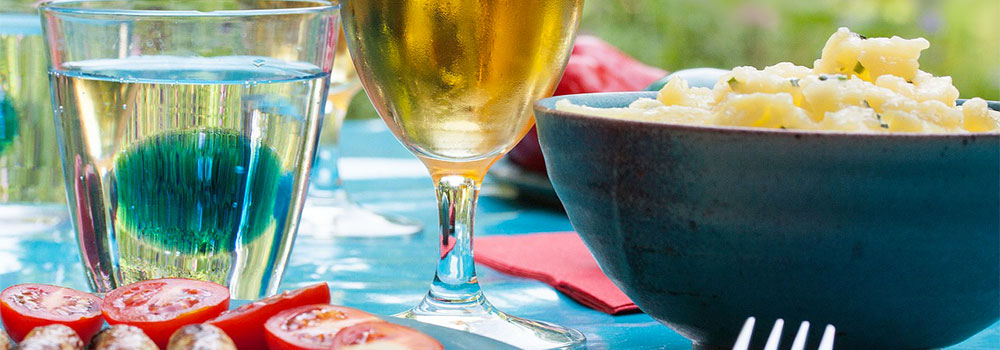
How to eat on a daily basis to be ready for UTMB® ?

Trail-running is a great way to escape our daily routine but we should not forget that this is an intense and stressful effort that must be accompanied by a rigorous food management before, during and after the race. Only four months to go before the event, so let's see how to feed on a daily basis to be ready for your UTMB®.
How should one eat on a daily basis ?
1.Lipid / fats
Certain components of food fats, polyunsaturated fatty acids, are essential in maintaining a healthy life. In particular they control inflammation generated by muscular effort and are essential components of cellular membranes.
Consume:
- Each day a minimum of 1 to 2 soup tablespoons of cold raw 1st pressing virgin oil, rapeseed, walnut, flax or camelina in seasoning vinaigrettes or on food (cooking makes them toxic). Think about keeping these oils in the fridge to maintain their nutritional values. Prioritise cold pressed olive oil for cooking.
- 2 or 3 three times a week fatty fish, preferably small fish (sardines, mackerel, anchovies) which contain less heavy metals than salmon or tuna. Regularly a few walnuts, hazelnuts or almonds: at breakfast or snacks, ground flax seeds, seaweed or purslane.
- A food rich in antioxidants ( fruit, vegetables, spices, whole grain cereal products) and cook on a low heat to protect the polyunsaturated fatty acids created by oxidative stress, particularly in sportspeople.
Limit, to the maximum, the consumption of fat rich meat (red meat, pork, meat in sauces, as well as some cold meats), fatty dairy products ( fresh cream, butter, cheese...), industrially made dishes, baking and industrial biscuits, crisps, pizzas quiches etc...
2. Carbohydrates
It is essential for anybody wishing to optimise their state of health, performance or weight controlI to prioritise carbohydrate foods with a low insulin secretion.
Prioritise :
- Carbohydrate foods with a low glycemic index: unrefined or non transformed cereal products : semi whole grain or whole grain cereals preferably organic – quinoa, rice semi-wholegrain basmati and products made from wholegrain flour or semi wholegrain, leguminous grains (lentils, broad beans, dried beans, chick peas, split peas, soya) ;
- Fruit rather than fruit juice;
- Fibre in each meal;
- Leavened bread with whole wheat flour or semi wholegrain cereals, rye, buckwheat…
- Consume protein at breakfast(boiled or poached egg, ham, cheese);
Limit :
- “Nibbling” sweet products during the day
- Carbohydrate foods with a high glycemic index notably at breakfast: refined sugars, fizzy drinks, biscuits, jams, chocolate or cereal bars without protein, sweet spreads, croissants and similar products, cakes/pastries, refined or transformed cereal products (white bread, white rice, pasta and all that made out of flour whose type is inferior to 80), potatoes, puffed cereals (breakfast cereals, biscuits or equivalent).
3. Proteins
They are a major constituent of muscular tissue, and whose contributions merit being optimised in daily life whether we are interested in sporting activities, want to lose weight or simply take care of our health.
There are several sources of proteins, those of plant origin and those of animal origin. The qualitative recommendations with regard to amino acids constituting proteins are to favour approximately 50% of animal derived protein and 50% plant derived protein. Yet at present, the French population globally consume too much animal protein to the detriment of plant protein. There are nevertheless multiple advantages of consuming leguminous grains, oil-yielding seeds or other alternative plants (soya, peas, broad-beans, lupin, hemp, etc.). Plant proteins deserve a special place in a sportsperson's daily menu.
4. « Full calories » rather than « empty calories »
We call « full calories » a food contribution not only for energy but also for being rich in vitamins, minerals, trace elements, antioxidants... unlike the « empty calories » which contain very little (they are mainly found in food stemming from industrial production). As for fruit and vegetables, a basic principle is to vary the colours to widen the pallet of micronutrients. Consuming products with an organic origin will optimise this contribution of micronutrients by around 30%! On a daily basis think about incorporating into you daily meals a raw plant source ( fruit or vegetables) and a cooked source, as often as possible (ideally 2 or 3 times a week), eat leguminous plants (lentils, broad-beans, dried beans, split peas, chick peas) starchy products ( rice, quinoa, millet, potatoes, pasta or bulgur with spelt...), spices and flavourings. Generally speaking, these foods possess what we call a low (weak) or average glycemic index : they only generate a weak secretion of insulin from the body and so favour concentration, performance and weight management.
5. Acid/base balance
It is important to keep a nutritional balance between bases and acids. Meats and nuts are going to tend to acidify the body, while starchy and leguminous foods do so to a lesser extent. On the contrary, fruit and vegetables are going to basify the body. So, it will be necessary to ensure that these 2 types of food are keep for the most part balanced. The 2 different sources must always be present on our plates.
Vous pourriez aussi aimer
A BOOK AND 12 ADVICES FOR A SUCCESSFUL UTMB®
In 2016, 42.5% of runners engaged in the UTMB® did not pass the finish line, which represents at least 1087 abandonments. And, amo...
16 likes 37 shares2019 TDS® , a new route
145 km and 9100 metres of height gain: bigger emotions, an even bigger challenge Exploring the Beaufortain The 11thedition of th...
111 likes 625 sharesA message from the organization
Dear community, We hear your many questions about the 2020 UTMB Mont-Blanc® and we think that these questions are legitimate. The...
43 likes 472 sharesUTMB® Mont-Blanc: the announcement you have all been waiting for
A message from Catherine and Michel Poletti, founders of the UTMB® Mont-Blanc Dear runners, dear community, We would like to than...
21 likes 253 shares